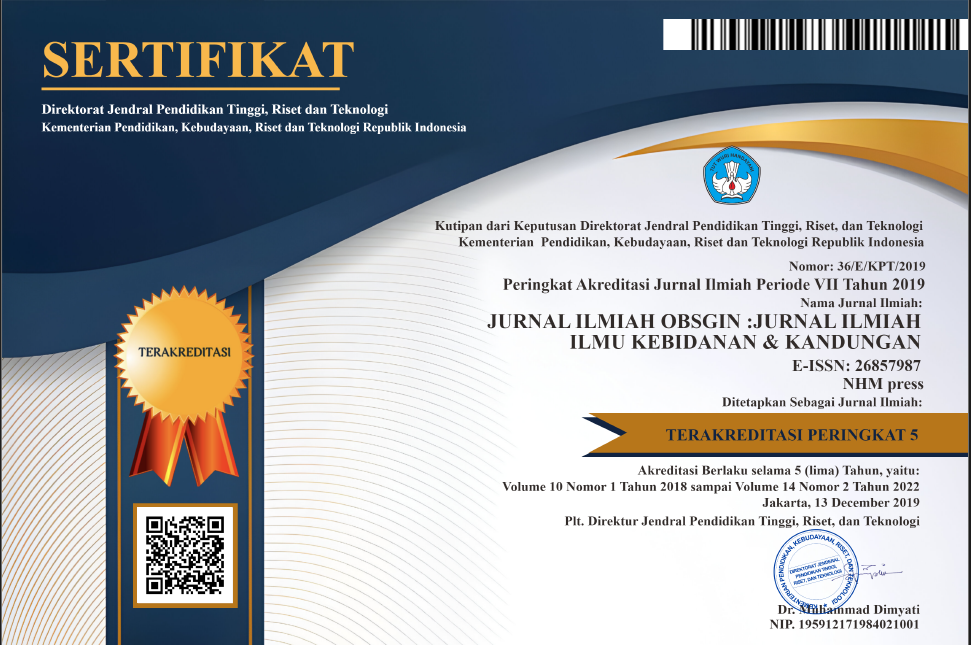HUBUNGAN USIA MENARCHE, LAMA MENSTRUASI, DAN STATUS GIZI DENGAN KEJADIAN DISMINORE PADA SISWI MA NURUL HIKMAH CINTA MANIS BARU
HUBUNGAN USIA MENARCHE, LAMA MENSTRUASI, DAN STATUS GIZI DENGAN KEJADIAN DISMINORE PADA SISWI MA NURUL HIKMAH CINTA MANIS BARU
Abstract
Dysmenorrhea is abdominal pain originating from uterine cramps during menstruation. The pain emerges concurrently with the onset of menstruation and lasts for several hours to several days until it reaches its peak. According to the World Health Organization (WHO), there is the prevalence of 1,769,425 cases (90%) of women experiencing dysmenorrhea, of which 10-15% suffer from severe dysmenorrhea. This is supported by research conducted in various countries with astonishing results, where the occurrence of primary dysmenorrhea in each country is reported to be more than 50%. The purpose of this study was to determine the relationship of age at menarche, menstrual period, nutritional status to the occurrence of dysmenorrhea in female students of Islamic senior high school. This was an analytical survey with a cross-sectional approach, involving 33 students. The data were analyzed by using the Chi-Square statistical test. The results of univariate analysis showed that 54.5% of the students experienced dysmenorrhea and 45.5% did not; 36.4% had abnormal age at menarche and 63.6% had normal age at menarche; 45.5% had abnormal menstrual period and 54.3% had normal menstrual period; as for nutritional status, 42.4% fell under the abnormal category and 57.6% under the normal category. The results of bivariate analysis showed a significant relationship. A significant relationship was found between age at menarche and the occurrence of dysmenorrhea, with the p-value of 0.032. A significant relationship also existed between menstrual period and the occurrence of dysmenorrhea, with the p-value of 0.002. Furthermore, a significant relationship was identified between nutritional status and the occurrence of dysmenorrhea, with the p-value of 0.043. It is recommended that healthcare workers should provide and improve health counseling on dysmenorrhea.
References
Hamdiyah. 2020. Hubungan Anemia Terhadap Dysmenorrhea (Nyeri Haid) Pada. Remaja Putri di Panti Asuhan Sejahtera Aisyiyah Sidrap. Madu Jurnal.
Kurniati, Amenlia, R, Oktora, M.Z., (2019) Hubungan Indeks Massa Tubuh dengan Kejadian Dismenore pada Mahasiswi Angkatan 2015 Fakultas Kedokteran Universitas Baiturrahmah Padang. Heme, Vol I No 2.
Kristianingsih, A. (2016). Faktor Risiko Dismenore Primer pada Siswi Sekolah Menengah Pertama (SMP X) Kecamatan Natar Kabupaten Lampung Selatan. Jurnal Aisyah : Jurnal Ilmu Kesehatan, 1(1), 19–27. https://doi.org/10.30604/jika.v1i1.4
Latthe, P., dan Khan, K. (2012). Dysmenorrhea. American Family Physician.
Setiawan, S. A. And Lestari, L. (2018) ‘Hubungan Nyeri Haid (Dismenore) Dengan Aktivitas
Sulfianti Et Al. Asuhan Kebidanan Pada Masa Nifas. (Yayasan Kita Menulis, 2021).
Karout N, Hawai SM, Altuwaijri S. Prevalence and pattern of menstrual disorders among Lebanese nursing students. East Mediterr Heal J [Internet]. 2012;18(4):346–52. Available from: http://applications.emro.who.int/emhj/v18/04/18_4_2012_0346_0352.pdf? ua=1Belajar Sehari-Hari Pada Remaja Putri Kelas VII Di SMPN 3 Pulung.’, Jurnal Delima Harapan, 8, Pp. 1–8
Sanday, S. D.,V. Kusumasari, dan D. N. A. Sari. 2019. Hubungan Intensitas Nyeri Dismenore dengan Aktivitas Belajar pada Remaja Putri Usia 15- 58 18 Tahun di SMAN 1 Banguntapan Yogyakarta. Jurnal Cakrawala Promkes 1(2):48-56.
Saputra, Y. A., Kurnia, A. D., & Aini, N. (2021). Pengaruh Pendidikan Kesehatan terhadap Upaya Remaja untuk Menurunkan Nyeri Saat Menstruasi (Dismenore Primer). Jurnal Kesehatan Reproduksi, 7(3), 177. https://doi.org/10.22146/jkr.55433
Sinaga, E., Saribanon N, Suprihatin, Sa’adah N, Salamah U.,. ManajemenKesehatan Menstruasi. Universitas Nasional. 2017.
Tangchai, et al. 2004. Dysmenorrhea in ThaiAdolescents:Prevalence, Impact andKnowledge of Treatment. J Med Assoc Thai. 87(suppl 3): s69-73.638-640.
Prawirohardjo, S. (2011) Psikologi Remaja. Jakarta: Rajawali Pers.
Wiknjosastro, Hanafi. 2012. Ilmu Kebidanan. Jakarta: Yayasan Bina Pustaka.
Soetjiningsih. 2012. Perkembangan Anak dan Permasalahannya dalam Buku Ajar I Ilmu. Perkembangan Anak Dan Remaja. Jakarta :Sagungseto
Silviani, Y. E., Karaman, B., & Septiana, P. (2019). Pengaruh Teknik Relaksasi Nafas Terhadap Dismenorea. Hasanuddin Journal of Midwifery, 1(1), 30. https://doi.org/10.35317/hajom.v1i1.1791
WHO (2019). Contraception. World Health Organization The Global Health.











